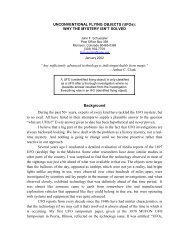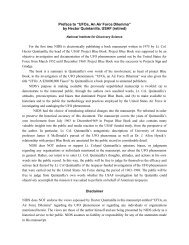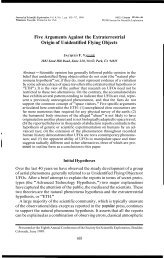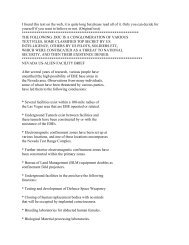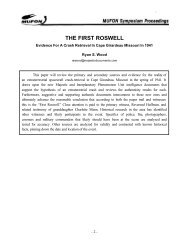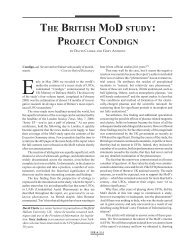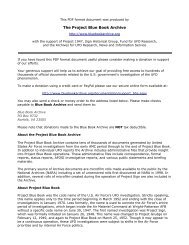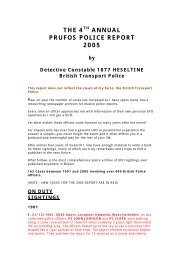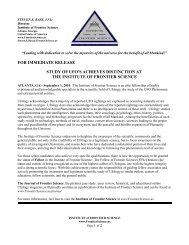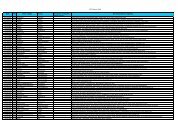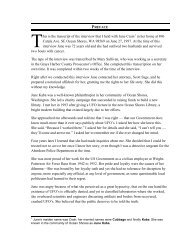Background-Brit Files, 2008 - UFO Casebook
Background-Brit Files, 2008 - UFO Casebook
Background-Brit Files, 2008 - UFO Casebook
Create successful ePaper yourself
Turn your PDF publications into a flip-book with our unique Google optimized e-Paper software.
Briefing document<br />
This briefing document should not be considered comprehensive and it is likely that<br />
further information can be found by undertaking bibliographic research and searching<br />
The National Archives’ Catalogue (http://www.catalogue.nationalarchives.gov.uk/).<br />
Clicking on the relevant links in this file will take you to the relevant catalogue entry.<br />
Unidentified Flying Objects (<strong>UFO</strong>s)<br />
1. What is a <strong>UFO</strong><br />
The first reports of 'flying saucers' being sighted were on 24 June 1947 from the<br />
Cascade Mountains of Washington state, USA. A private pilot, Kenneth Arnold, reported<br />
seeing nine strange objects that moved at tremendous speed across the sky ‘like a<br />
saucer skipping on water’. His sighting triggered a wave of similar reports from<br />
observers in North America and across the world. On 8 July 1947 a report came from<br />
Roswell, New Mexico, that a disc-shaped object had landed on a remote ranch and had<br />
been removed for examination by officers from the US Eighth Army Headquarters. The<br />
age of the flying saucer had arrived.<br />
The acronym <strong>UFO</strong> is an abbreviation for the US Air Force term ‘Unidentified Flying<br />
Object.’ It was coined in 1950 by Captain Edward Ruppelt of ‘Project Blue Book’, the<br />
USAF’s official '<strong>UFO</strong> project', to replace flying saucers, a term that was widely used by<br />
the media and public. A flying saucer is defined in the Oxford English Dictionary as ‘a<br />
disc or saucer-shaped object reported as appearing in the sky and alleged to come from<br />
outer space’.<br />
Although for the public and the media <strong>UFO</strong> has since become a synonym for ‘alien<br />
spaceship,’ for the military forces of the world it is simply refers to something in the sky<br />
the observer can see but does not recognise. In the vast majority of cases,<br />
investigations have discovered ordinary explanations for <strong>UFO</strong> reports such as bright<br />
stars and planets, meteors, artificial satellites, balloons, aircraft seen from unusual<br />
angles and space junk burning up in the atmosphere. However, there are some cases<br />
on record where no common explanation can be found. For the Ministry of Defence,<br />
these types of report remain ‘unidentified’ rather than ‘extraterrestrial’. Some branches of<br />
the MoD, such as the Defence Intelligence Staff (DIS), prefer the term UAP (unidentified<br />
aerial phenomena) to describe those <strong>UFO</strong>s that remain unidentified. UAP does not imply<br />
the existence of an ‘object’ of extraterrestrial origin.<br />
2. <strong>UFO</strong>s in the early 20 th century: 1909-1950<br />
An understanding of the factors that lay behind the <strong>Brit</strong>ish government’s interest in the<br />
<strong>UFO</strong> issue can be found by studying the range of documents available at The National<br />
Archives. The vast majority of the records are found in the post Second World War<br />
period. This reflects the growing post-war fascination with the idea of <strong>UFO</strong>s as<br />
extraterrestrial visitors, as portrayed in popular science fiction films such as The Day the<br />
Earth Stood Still (1951). In contrast, official policy was restricted to establishing whether<br />
<strong>UFO</strong> sightings could be considered to be a threat to national security. During the Cold<br />
1
War, for example, the major threat came from behind the Iron Curtain. Once Soviet<br />
aircraft were discounted, the identity of a <strong>UFO</strong> was of no further interest to the <strong>Brit</strong>ish<br />
military.<br />
To understand the origins of the <strong>Brit</strong>ish government's interest in <strong>UFO</strong>s it is necessary to<br />
look back to an earlier period of 20th century history. In 1909 and 1913 phantom<br />
airships - dark cigar-shaped flying objects carrying searchlights - were sighted at night<br />
moving over many <strong>Brit</strong>ish towns and cities. As tension grew in the build up to the First<br />
World War, newspapers and some politicians accused the Germans of sending Zeppelin<br />
airships to spy on dockyards and other strategic areas around the <strong>Brit</strong>ish coastline.<br />
In October 1912, when sightings of an unidentified aircraft were made over the Royal<br />
Navy torpedo school at Sheerness, Essex, questions were asked in the House of<br />
Commons. This led the First Lord of the Admiralty, Winston Churchill, to order an<br />
investigation. Inquiries by naval intelligence failed to establish the identity of the aircraft<br />
but the Germans were widely believed to be responsible. The relevant papers are in AIR<br />
1/2455 and AIR 1/2456.<br />
Both the War Office and Admiralty investigated further sightings of unidentified airships,<br />
aircraft and mysterious moving lights. These were usually seen at night and were<br />
frequently reported to the military authorities from many parts of the <strong>Brit</strong>ish Isles during<br />
the First World War. In 1916 a War Office intelligence circular found that 89 percent of<br />
the reports could be explained by bright planets, searchlights and natural phenomena. It<br />
concluded: ‘There is no evidence on which to base a suspicion that this class of enemy<br />
activity ever existed’ ('Alleged Enemy Signalling 1916', WO 158/989).<br />
More sightings of aerial phenomena were made during the Second World War by RAF<br />
aircrew. These included balls of fire and mysterious moving lights that appeared to<br />
pursue Allied aircraft operating over occupied Europe. American pilots dubbed these<br />
<strong>UFO</strong>s ‘foo-fighters’, from a character in a comic strip whose catch phrase was ‘where<br />
there's foo there's fire.’ Although the foo-fighters did not appear to be hostile the<br />
sightings alarmed air intelligence branches of the Air Ministry and US Army Air Force<br />
as they prepared for the invasion of France. The RAF began to collect reports of ‘night<br />
phenomena’ from 1942 and later in the war, the Air Ministry shared intelligence on the<br />
subject with the US authorities. They assumed the phenomena were German secret<br />
weapons, such as the Me262 jet fighter. At the end of the war no traces of advanced<br />
aircraft or weapons that could explain the ‘foo fighters’ were found by the Allied<br />
occupying forces. In addition, intelligence officers such as Dr RV Jones discovered that<br />
German pilots had observed similar unexplained aerial phenomena. (See bibliography)<br />
Air Ministry reports on ‘night phenomena’ are at AIR 2/5070 while reports from aircrew<br />
with Bomber Command's 115 Squadron in December 1943 can be found in AIR<br />
14/2800.<br />
In 1946 and 1947 the War Office and Air Ministry became involved in an investigation of<br />
mysterious ghost rockets sighted over Scandinavia. Initially intelligence officers at the<br />
Air Ministry believed the ‘flying bombs’ (RV Jones memoirs, ‘Most Secret War’ chapter<br />
52, pg 510-11, 1978) were modified V2 rockets fired by Soviets, from captured Nazi<br />
rocket plant at Peenemunde in the Baltic. Dr RV Jones, Director of Intelligence at the Air<br />
Ministry in 1946, was sceptical of this theory. Drawing upon his wartime experiences, he<br />
2
elieved the scare was triggered by sightings of bright meteors in countries that feared<br />
Soviet expansion. Reports and correspondence between the Foreign Office, Air Ministry<br />
and the <strong>Brit</strong>ish air attaché in Stockholm are contained in FO 371/56988 and FO<br />
371/56951. An air intelligence report on the ‘ghost rockets’ of 1946 can be found in AIR<br />
40/2843.<br />
Reports of ghost rockets preceded by six months the first sightings of ‘flying saucers’<br />
over the mainland of the United States. In December 1947 the newly created US Air<br />
Force set up a project, code-named Sign to investigate the growing mystery. USAF<br />
Lieutenant General Nathan F Twining's initial conclusion was ‘the phenomenon reported<br />
is something real and not imaginary or fictitious.’ (See further reading)<br />
3. <strong>Brit</strong>ish Government interest, 1950-1951<br />
The <strong>Brit</strong>ish Government did not begin any official inquiry into the <strong>UFO</strong> mystery until<br />
1950. During the spring and summer of that year a large number of 'flying saucer'<br />
sightings were made in <strong>Brit</strong>ain for the first time and the media started to take an interest.<br />
Two Sunday newspapers serialised the first books on the topic that had been published<br />
in the USA. This led a number of senior figures, both in the establishment and the<br />
scientific community to treat the subject seriously for the first time. The Sunday Dispatch<br />
was encouraged to publish stories by Lord Louis Mountbatten, who was later to become<br />
Chief of Defence Staff. Mountbatten was one of a small group of influential military<br />
officials who believed <strong>UFO</strong>s were real and of interplanetary origin.<br />
Another senior official who took reports of <strong>UFO</strong>s seriously was Sir Henry Tizard. He is<br />
best known for his work on the development of radar before the Second World War.<br />
Post-war Tizard became Chief Scientific Advisor to the Ministry of Defence and came to<br />
believe that ‘reports of flying saucers should not be dismissed without some<br />
investigation’ (DEFE 41/74). It was as a direct result of his influence that the MoD was<br />
asked to set up a small team of experts to investigate reports of flying saucers under the<br />
Directorate of Scientific Intelligence/Joint Technical Intelligence Committee (DSI/JTIC).<br />
The Flying Saucer Working Party operated under such secrecy that its existence was<br />
known to very few. However, a reference to a study of flying saucers emerged in 1988<br />
when a file of correspondence between Winston Churchill and the Air Ministry was<br />
opened under the 30-year rule, PREM 11/855. On 28 July 1952 the Prime Minister<br />
asked the Air Minister: 'What does all this stuff about flying saucers amount to What<br />
can it mean What is the truth Let me have a report at your convenience.' The<br />
response, dated 9 August 1952, began 'The various reports about unidentified flying<br />
objects, described by the Press as “flying saucers”, were the subject of a full intelligence<br />
study in 1951'.<br />
Several unsuccessful attempts were made to trace this study but in 1998 the minutes of<br />
the DSI/JTIC were released in DEFE 41/74 and DEFE 41/75. These revealed how the<br />
working party was established in August 1950 under the following terms of reference:<br />
• 1. To review the available evidence in reports of 'Flying Saucers'.<br />
• 2. To examine from now on the evidence on which reports of <strong>Brit</strong>ish origin of<br />
phenomena attributed to 'Flying Saucers' are based.<br />
• 3. To report to DSI/JTIC as necessary.<br />
3
• 4. To keep in touch with American occurrences and evaluation of such (DEFE<br />
41/74.)<br />
The working party included intelligence officers from each of the three armed services<br />
and was chaired by G. L. Turney, head of scientific intelligence at the Admiralty. This<br />
team reviewed what was known about the subject and investigated a number of<br />
sightings reported to it by RAF Fighter Command. During their inquiries they questioned<br />
a group of test pilots from the Royal Aircraft Establishment at Farnborough who had<br />
reported sightings of aerial phenomena. In June 1951 the working party produced a brief<br />
final report that debunked the sightings and concluded that flying saucers did not exist. A<br />
surviving copy of DSI/JTIC Report No 7 was found in MoD archives in 2001. It was<br />
released in the following year in DEFE 44/119. A copy of the original report and covering<br />
letter to Sir Henry Tizard are in DEFE 19/9, released in July <strong>2008</strong> at The National<br />
Archives.<br />
Classified as 'Secret/Discreet' the six-page report concluded that all <strong>UFO</strong> sightings could<br />
be explained as misidentifications of ordinary objects or phenomena, optical illusions,<br />
psychological delusions or hoaxes. They concluded with the following statement: 'We<br />
accordingly recommend very strongly that no further investigation of reported mysterious<br />
aerial phenomena be undertaken, unless and until some material evidence becomes<br />
available.' (See DEFE 44/119)<br />
The members of the working party relied heavily upon information supplied by the US Air<br />
Force <strong>UFO</strong> project (now renamed Grudge) and the CIA. US policy was to debunk the<br />
subject and restrict the release of information to the public about <strong>UFO</strong> sightings made by<br />
the armed services. The Assistant Director of the CIA's Office of Scientific Intelligence,<br />
Dr Harris Marshall Chadwell, was present at the meeting of DSI/JTIC in 1951 when the<br />
report was delivered to MoD. American influence upon the team's methodology can be<br />
seen both in the adoption of the USAF term <strong>UFO</strong> in its title and the conclusions.<br />
Circulation was restricted within MoD with just one copy sent to Sir Henry Tizard.<br />
4. Air Ministry investigations 1952-64<br />
The sceptical conclusions of the Flying Saucer Working Party set the template for all<br />
future <strong>Brit</strong>ish policy on <strong>UFO</strong>s. After the report was delivered the team was dissolved and<br />
investigations ended. However, during the summer of the following year a new wave of<br />
sightings were made across the world. In July 1952, as Cold War tension increased,<br />
<strong>UFO</strong>s were detected by radars in the US capital Washington DC, prompting the USAF to<br />
scramble jet interceptors. The scare made headlines across the world and led Winston<br />
Churchill to send his famous memo to the Air Ministry on ‘flying saucers.’<br />
The Prime Minister was told on 9 August 1952 that ‘nothing has happened since 1951 to<br />
make the Air Staff change their opinion, and, to judge from recent Press statements, the<br />
same is true in America’ (PREM 11/855). In September this policy was revised as a<br />
direct result of further <strong>UFO</strong> sightings that occurred during a major NATO exercise in<br />
Europe. The most dramatic were those reported by a group of Shackleton aircrew who<br />
saw a circular silver object appear above the airfield at RAF Topcliffe in North Yorkshire.<br />
In a report made to the base Commanding Officer one of the men, Flt Lt John Kilburn of<br />
269 Squadron, RAF, said he watched as the object appeared to descend to follow a<br />
4
Meteor jet, rotated on its own axis and then accelerated away at a speed ‘in excess of a<br />
shooting star’ (AIR 16/1199).<br />
According to Capt Edward Ruppelt, of Project Blue Book, it was the Topcliffe sighting<br />
that ‘caused the RAF to officially recognise the <strong>UFO</strong>.’ Soon afterwards the Air Ministry<br />
decided to monitor <strong>UFO</strong> reports on a permanent basis. Responsibility was delegated by<br />
the Chief of Air Staff to a branch within the Deputy Directorate of Intelligence (DDI<br />
(Tech) known as AI3 (DEFE 31/118). In December 1953 HQ Fighter Command issued<br />
orders to all RAF stations that in future reports of 'aerial phenomena' should be reported<br />
directly to DDI (Tech), Air Ministry, for further investigation. The order said it was<br />
important that details of sightings made by RAF personnel and from radar stations<br />
should be carefully examined and its release 'controlled officially.' The Air Ministry letter<br />
stated that 'all reports are to be classified 'Restricted' and personnel are warned not to<br />
communicate to anyone other than official persons any information about phenomena<br />
they have observed, unless officially authorised to do so' (AIR 20/9994).<br />
From 1953 reports from all sources were sent to DDI (Tech) for 'examination, analysis<br />
and classification'. Advice on likely explanations was obtained from Fighter Command,<br />
the Meteorological Office and the Royal Greenwich Observatory. Each year a special<br />
report ‘summarising all <strong>UFO</strong> sightings by types' was submitted to the Air Staff (DEFE<br />
31/118). None of these summaries have survived before 1956. However, an analysis of<br />
80 reports up to 1954 formed the basis of an article published in Vol 10, No 3 of the Air<br />
Ministry Secret Intelligence Summary (AMSIS) during March 1955 (DEFE 31/118 and<br />
AIR 40/2769). This summary, based upon a longer report now lost, was classified<br />
'Secret - UK Eyes Only.'<br />
The existence of this summary study came to light in May 1955 when the Conservative<br />
MP Major Patrick Wall asked the Secretary of State for Air, in a Parliamentary Question,<br />
if he would publish the 'report on flying saucers recently completed by the Air Ministry.’ In<br />
reply the Air Minister George Ward said: ‘reports of "flying saucers" as well as any other<br />
abnormal objects in the sky, are investigated as they come in, but there has been no<br />
formal inquiry. About 90 percent of the reports have been found to relate to meteors,<br />
balloons, flares and many other objects. The fact that the other 10 percent are<br />
unexplained need be attributed to nothing more sinister than lack of data' (AIR 2/16918).<br />
The outstanding 10 percent of 'unexplained' sightings remained <strong>UFO</strong>s (or, as the Air<br />
Ministry preferred, 'insufficient information'). This explains the policy decision to continue<br />
collecting reports to the present day. The reasons given in the AMSIS article were that<br />
'there is always the chance of observing foreign aircraft of revolutionary design.' This<br />
factor remained a concern for intelligence agencies until the end of the Cold War. The<br />
Air Ministry was careful to qualify this interest with this caveat: '...as for controlled<br />
manifestations from outer space, there is no tangible evidence of their existence' (AIR<br />
40/2769).<br />
The Joint Intelligence Committee (JIC) initiated inquiries into ‘aerial phenomena’ on two<br />
occasions during the late 1950s. Following press reports of <strong>UFO</strong>s tracked by radars at<br />
RAF West Freugh, Scotland, in April 1957 the Air Ministry informed the JIC it was<br />
unable to explain four recent incidents (CAB 157/27). Aerial phenomena were again the<br />
subject of JIC discussion in March 1959 following a sighting made at London airport<br />
(CAB 159/31).<br />
5
5. MoD investigations 1964-present<br />
From 1958 an civilian Air Staff secretariat branch known as S6 (Air) took over<br />
responsibility for dealing with public relations on the topic of <strong>UFO</strong>s. During that year an<br />
S6 desk officer decided their policy would be 'politely unhelpful' in response to any public<br />
or press inquiry on the subject (DEFE 31/118). From this point onwards two separate<br />
branches of the Air Ministry were involved in dealing with the <strong>UFO</strong> problem. DDI (Tech),<br />
was responsible for investigating reports and assessing their defence significance, whilst<br />
S6 (Air) fielded questions from members of the public, the press and MPs.<br />
In 1964 the Air Ministry became part of the new Ministry of Defence and the three<br />
separate service intelligence sections of the Army, Navy and RAF were merged under a<br />
new unified structure. S6's <strong>UFO</strong> remit passed to a new MoD secretariat, S4 (Air) and in<br />
1967 responsibility for inquiries into <strong>UFO</strong> incidents deemed to have possible defence<br />
significance were inherited by a Defence Intelligence branch, DI55.<br />
Although more than 11,000 <strong>UFO</strong> reports have been logged by DI55, S4 (Air) and a<br />
number of other MoD branches between 1959 and 2007, no detailed studies have been<br />
carried out on the accumulated data until relatively recently. Following a new wave of<br />
sightings in 1967 the Government faced a series of Parliamentary questions on their<br />
<strong>UFO</strong> investigations and policy. In response, the head of S4 (Air), James Carruthers,<br />
produced a detailed briefing for the Secretary of State for Air, Merlyn Rees MP. In his<br />
report dated November 1967 Carruthers said the MoD had kept a statistical analysis of<br />
<strong>UFO</strong> reports received since 1959 'and has found no evidence to suggest [<strong>UFO</strong>s] have<br />
other than mundane explanations.' He added that MoD 'does not consider that a<br />
separate study by [UK] Government departments or by a university or other independent<br />
organisation would produce results to justify the expenditure, time and money involved'<br />
(DEFE 31/119).<br />
Following the conclusions reached by the Flying Saucer Working Party the MoD<br />
continued to reply upon studies carried out by USAF for their policy lead on <strong>UFO</strong>s. There<br />
was never any <strong>Brit</strong>ish equivalent of the publicly funded study by the University of<br />
Colorado on behalf of the USAF that was completed in 1969. The 'Condon report' -<br />
named after the project head, the physicist Dr Edward Condon - was based on an<br />
analysis of 12,618 reports collected by the USAF Project Blue Book between 1947 and<br />
1969 (Blue Book followed Projects Sign and Grudge in 1952). Of this total 701<br />
remained unexplained. The main findings of the US study were:<br />
• About 90% of all <strong>UFO</strong> reports prove to be plausibly related to ordinary<br />
phenomena.<br />
• Little, if anything, had come from the study of <strong>UFO</strong>s in the past 21 years that<br />
added to scientific knowledge.<br />
• Further extensive study of <strong>UFO</strong> sightings was not justified in the expectation that<br />
science will be advanced thereby.<br />
• No evidence came to light in the study to indicate that <strong>UFO</strong> sightings may<br />
represent a defence hazard.<br />
• The Department of Defence should continue to handle <strong>UFO</strong> reports in its normal<br />
surveillance operations without the need for special units such as Project Blue<br />
Book (S4 briefing to MoD, 24 March 1970, copy in BJ 5/311).<br />
6
Project Blue Book was closed by USAF following publication of the Condon report in<br />
December 1969. In the UK the MoD used the findings to further reduce their workload on<br />
<strong>UFO</strong>s. From 1973 members of the public who reported sightings received only a polite<br />
acknowledgement. Unlike the USAF, the MoD decided it should continue to maintain an<br />
interest in the subject so that it could answer questions from MPs and where necessary,<br />
reassure the public that <strong>UFO</strong>s posed no threat to national defence. This policy rethink,<br />
the first of many, took place between 1970 and 1975 and the papers can be found in AIR<br />
2/19086.<br />
The last time the Government made a full public statement on its policy was in January<br />
1979 when <strong>UFO</strong>s were the subject of a lengthy debate in the House of Lords. This was<br />
initiated by Lord Clancarty (Brinsley le Poer Trench), the author of several books on<br />
<strong>UFO</strong>s and related subjects. Clancarty believed the MoD had evidence that <strong>UFO</strong>s were<br />
of extraterrestrial origin and was convinced they were concealing ‘the truth’ from the<br />
public. In the summer of 1978 he tabled a motion that called on the Government to set<br />
up an inquiry and for the Defence Minister to make a televised statement on <strong>UFO</strong>s. In<br />
the Lords, the Government's response was delivered by a retired Royal Navy officer and<br />
Labour peer, Lord Strabolgi (David Kenworthy). His closing remarks were: ‘…as for<br />
telling the public the truth about <strong>UFO</strong>s, the truth is simple. There really are many strange<br />
phenomena in the sky, and these are invariably reported by rational people. But there is<br />
a wide range of natural explanations to account for such phenomena. There is nothing to<br />
suggest to Her Majesty’s Government that such phenomena are alien spacecraft’ ( AIR<br />
20/12966).<br />
6. Key Documents Held at the National Archives<br />
Keyword searches on the Catalogue using ‘<strong>UFO</strong>’ or ‘U.F.O’ or ‘(unidentified NEAR<br />
flying)’ and ‘flying saucers’ will produce a list of most of the relevant files held at the<br />
National Archives. This search can be carried out by clicking here: catalogue search for<br />
<strong>UFO</strong> files.<br />
Various documents held at The National Archives give a history of the <strong>Brit</strong>ish<br />
Government’s involvement in the <strong>UFO</strong> issue and an insight into the politics and<br />
personalities responsible for shaping official policy. The official reporting, analysis and<br />
recording of <strong>UFO</strong> sightings commenced in the early 1950s, but substantial records at the<br />
National Archives begin in 1962. Until 1967 MoD policy was to destroy <strong>UFO</strong> files at five<br />
yearly intervals because they were deemed to be of ‘transitory interest’; as a result a<br />
large number of records dating from the period before 1962 have been lost. This policy<br />
was rescinded as a direct result of pressure from the MP Sir John Langford-Holt in 1970<br />
(AIR 2/19086 and DEFE 13/1183). Since then most surviving MoD <strong>UFO</strong> files have been<br />
reviewed for eventual release at The National Archives. A note attached to a file dated<br />
1988 reads: “in accordance with ministerial instructions, all <strong>UFO</strong> files are to be<br />
permanently preserved, in view of the public interest in this subject’ (DEFE 24/1928/1).<br />
The surviving records generally consist of four categories of material:<br />
1) <strong>UFO</strong> policy;<br />
2) Parliamentary business including responses to Parliamentary Questions (PQs)<br />
and Parliamentary Enquiries (PEs);<br />
3) Public correspondence;<br />
7
4) <strong>UFO</strong> sighting reports<br />
There are several files documenting the UK Government’s policy on <strong>UFO</strong>s, including<br />
references to how and by whom it was drawn up and how it evolved. These papers<br />
illustrate how a number of different branches and divisions with MoD were involved at<br />
different times handling policy and investigations. Policy files created by the former Air<br />
Ministry DDI (Tech) and their successor, the Defence Intelligence Staff, can be found at<br />
references DEFE 31/118 (1953-1963) and DEFE 31/119 (1967). Air Staff policy can be<br />
followed at AIR 20/11612 (1967-68), AIR 2/18117 (1967) and AIR 2/19086 (1970-75)<br />
Examples of Parliamentary correspondence can be found at DEFE 24/1535. This file<br />
also contains papers relating to the <strong>Brit</strong>ish Government’s response to the Prime Minister<br />
of Grenada’s attempts to table a debate on <strong>UFO</strong>s at the United Nations in 1977-78.<br />
Other contents include references to the French Government’s <strong>UFO</strong> policy and the study<br />
group established by the French Space Agency, based at Toulouse. A series of files<br />
contains responses to Parliamentary Enquiries on <strong>UFO</strong>s, at DEFE 13/1183, DEFE<br />
13/1187, DEFE 13/1188 and DEFE 71/97-100 . There is a substantial collection of<br />
papers relating to the <strong>UFO</strong> debate held in the House of Lords in January 1979. A<br />
number of MoD branches, along with the Foreign Office and the Department of Science<br />
& Energy, contributed to the Government's response in the Lords. DEFE 19/253<br />
contains RAF Chief Scientist papers, DEFE 31/172 contains DIS papers, while AIR<br />
20/12966 is the Head of S4 (Air)’s file on the debate and its aftermath.<br />
<strong>UFO</strong> report files contain a mixture of letters from members of the public and reports<br />
from official sources such as the police, coastguard and Civil Aviation Authority (CAA).<br />
Many reports take the form of military signals received by MoD via a variety of RAF and<br />
RN stations. The most frequent method of reporting a <strong>UFO</strong> sighting was via a standard<br />
proforma, originally based on a USAF questionnaire. An early draft of this report format<br />
can be found at DEFE 31/118. A version of this questionnaire is still used today by the<br />
Ministry of Defence. The proforma contains 16 questions, a-q:<br />
• (a) Date, time and duration of sighting<br />
• (b) Description of object<br />
• (c) Exact position observer<br />
• (d) How observed<br />
• (e) Direction in which object was first seen<br />
• (f) Angle of sight<br />
• (g) Distance<br />
• (h) Movements<br />
• (j) Meteorological conditions during observations<br />
• (k) Nearby objects<br />
• (l) To whom reported (police, military organisations, the press etc)<br />
• (m) Name and address of informant<br />
• (n) Any background on the informant that may be volunteered<br />
• (o) Other witnesses<br />
• (p) Date and time of receipt of report<br />
• (q) Is a reply requested (Note item q was deleted from 1973).<br />
From 1966-67 <strong>UFO</strong> reports and correspondence between members of the public and<br />
MoD were preserved in two separate sequences of files. Five separate file series held at<br />
8
The National Archives contain papers relating to <strong>UFO</strong> sightings and <strong>UFO</strong><br />
correspondence from 1962 in chronological order:<br />
AIR 2/16918 features numerous sighting reports and correspondence from members of<br />
the public to the Air Ministry secretariat S6, between 1961 and 1963. On the<br />
reorganization of MoD in 1964 a new Secretariat, S4 (Air), took over responsibility for<br />
<strong>UFO</strong> matters. <strong>UFO</strong> reports and correspondence from 1967 can be found in AIR 2/18115<br />
and AIR 2/18116, 1967-68 in AIR 2/18117, and 1968-69 in AIR 2/18183. AIR 2/18871<br />
contains reports and newspaper cuttings from 1972, while AIR 2/18872 consists of a<br />
collection of <strong>UFO</strong> reports and correspondence 1972-1973; AIR 2/18873, 1973-1974; and<br />
AIR 2/18874 likewise for 1974-1975. A series of files containing <strong>UFO</strong> reports runs from<br />
February 1974 until December 1976 and begins in AIR 2/18950. AIR 2/19126 contains a<br />
statistical analysis of <strong>UFO</strong> reports made to MoD between 1967 and 1973.<br />
AIR 20 files include a number of Air Ministry <strong>UFO</strong> papers that escaped destruction<br />
before 1967. AIR 20/7390 contains reports of unidentified objects/aircraft made to Air<br />
Ministry between 1950 and 1954. AIR 20/9320, AIR 20/9321 and AIR 20/9322 contain<br />
Parliamentary Questions and briefings on <strong>UFO</strong>s reported in 1957, including reports of<br />
phenomena tracked by radar. AIR 20/9994 also contains papers from RAF radar stations<br />
concerning ‘reports of aerial phenomena’ during 1957. A further series containing <strong>UFO</strong><br />
sighting reports made to S4 (Air), filed in monthly folders covering the period August<br />
1967 through to December 1973, begins in AIR 20/11887 and end in AIR 20/12555.<br />
A third series of files, in DEFE 24, contains the majority of the surviving reports and<br />
public correspondence from 1977 onwards. DEFE 24/1206 covers 1977 and DEFE<br />
24/1207, 1977-78. These files contain papers from a number of MoD secretariats. S4<br />
(Air) was replaced by DS8 (Defence Secretariat 8) in 1979. In turn DS8’s <strong>UFO</strong><br />
responsibility passed to Secretariat (Air Staff) 2 or Sec (AS) in 1985. DEFE 24 also<br />
contains a series of ‘edited copies’ of <strong>UFO</strong> reports received by MoD, covering the years<br />
1975-1980. These are duplicates of the main reports series, prepared at a time when the<br />
MoD first considered the release of <strong>UFO</strong> material to the public. The identities and home<br />
addresses of observers have been deleted from the edited reports. A MoD proposal to<br />
make selected reports available on request to members of the public was reversed in<br />
1984 by defence minister John Stanley on the grounds of cost (DEFE 24/1517).<br />
A total of 17 DS8 and Sec (AS) files were opened under the Freedom of Information Act<br />
during <strong>2008</strong>. DEFE 24/1925/1 contains public correspondence 1985-86. DEFE<br />
24/1929/1, DEFE 24/1930/1, DEFE 24/1931/1, DEFE 24/1941/1, DEFE 24/1941/1,<br />
DEFE 24/1942/1 DEFE 24/1949/1 DEFE 24/955/1 DEFE 24/1956/1 and DEFE<br />
24/1957/1 contain correspondence 1986-1992 and can all be accessed through<br />
nationalarchives.gov.uk/ufos.<br />
DS8 and Sec(AS) <strong>UFO</strong> reports files opened during <strong>2008</strong> include DEFE 24/1922/1, DEFE<br />
24/1923/1, DEFE 24/1924/1 (1984-85), DEFE 24/1926/1-1928/1 (1986-88), (1988-89),<br />
DEFE 24/1939/1 – 40/1 (1989-1990), DEFE 24/1953/1 – 54/1 (1991-92).<br />
DEFE 31 contains a series of <strong>UFO</strong> records created by the Defence Intelligence Staff<br />
branch DI55 and their predecessors, Air Ministry DDI (Tech). Policy files are DEFE<br />
31/118 and DEFE 31/119. <strong>UFO</strong> report files include DEFE 31/171 (1975-76) and DEFE<br />
31/163 through to DEFE 31/167 (1979).<br />
9
Four files in the DI55 <strong>UFO</strong> reports sequence were opened in May <strong>2008</strong>. These are<br />
DEFE 31/172/1 (<strong>UFO</strong> reports 1978-1983), DEFE 31/173/1 (<strong>UFO</strong> reports June 1983-<br />
March 1985), DEFE 24/174 (<strong>UFO</strong> reports April 1985-December 1986) and DEFE<br />
31/175/1 (<strong>UFO</strong> reports December 1986-November 1987).<br />
Short sequences of RAF Air Defence/Operations <strong>UFO</strong> files that have survived<br />
destruction include DEFE 71/3 (<strong>UFO</strong> reports 1975-77) and DEFE 71/4 (<strong>UFO</strong> reports<br />
1977).<br />
Details of some well-documented <strong>UFO</strong> sightings investigated by the Air Ministry and<br />
Ministry of Defence can be found by searching the reports files. AIR 2/18564 and AIR<br />
20/9320 contain reports from various RAF stations including RAF West Freugh in 1957.<br />
The West Freugh incident involved the tracking of <strong>UFO</strong>s by a number of trailer-mounted<br />
radar units at a RAF bombing range in southern Scotland. It led to national interest when<br />
the story leaked to the press. Newspaper stories led to questions in Parliament and at<br />
the Joint Intelligence Committee (JIC). A report on the incident prepared by DDI (Tech)<br />
contains in its conclusions what is possibly the closest the Air Ministry ever got to<br />
recognition that some <strong>UFO</strong>s remained inexplicable and therefore of possible defence<br />
interest. The report stated: ‘It is concluded that the incident was due to the presence of<br />
five reflecting objects of unidentified type and origin. It is considered unlikely that they<br />
were conventional aircraft, meteorological balloons or charged clouds’ (AIR 20/9321).<br />
AIR 20/11889 and AIR 20/11890 contain papers and reports on a 'flying cross' sighted<br />
by police officers and other witnesses in Devon, Sussex and elsewhere during October<br />
1967. Papers from 1967-68 also contain details of field investigations of selected <strong>UFO</strong><br />
reports carried out by S4 (Air) and DI55. AIR 2/19083 contains brief details of the socalled<br />
Berwyn Mountains <strong>UFO</strong> incident, reported in North Wales in January 1974. AIR<br />
2/19125 is a collection of <strong>UFO</strong> sightings compiled by staff at RAF Patrington in North<br />
Yorkshire – referred to as 'reports of unusual occurrences (<strong>UFO</strong>).' This includes details<br />
of sightings made by civilians, police, and various flight personnel from the station<br />
between 1968 and 1973.<br />
DEFE 24/1943/1, transferred to The National Archives during <strong>2008</strong>, contains a collection<br />
of letters sent to the MoD between 1985 and 1992 describing alleged ‘close encounter<br />
reports, alien entities and [alien] abductions.’<br />
AVIA 65/33 contains papers and photographs relating to Project Y (1953-55), a<br />
Canadian proposal to design a saucer-shaped vertical take off (VTOL) aircraft. This file<br />
shows that both the Air Ministry and Ministry of Supply wished to develop ideas for<br />
saucer-shaped aircraft but no progress was made due to cost and technical difficulties.<br />
Further papers on ‘unorthodox aircraft’ designs, including flying saucers, from 1949-52<br />
can be found in DEFE 41/117 and DEFE 41/118.<br />
BJ 5/311 contains papers collected by the Meteorological Office relating to <strong>UFO</strong> reports<br />
and policy 1968-1970. The Met Office have provided technical advice to the Air Staff<br />
secretariat on <strong>UFO</strong> matters since 1950, but this is the only surviving file containing<br />
evidence of their input to official policy.<br />
10
DEFE 71/33 contains a brief discussion between RAF, Air Traffic Control and the<br />
Defence Intelligence Staff concerning <strong>UFO</strong>s as a potential hazard to civil aviation, 1977-<br />
78.<br />
AIR 2/19119 and AIR 2/19117 contains papers relating to the MoD's involvement in two<br />
BBC TV productions on <strong>UFO</strong>s. In 1972 the head of S4 (Air), Anthony Davies, appeared<br />
on a <strong>UFO</strong> debate screened by BBC2's Man Alive series. He was also interviewed by<br />
BBC Radio Oxford for a programme broadcast later that year. DEFE 24/1565 contains a<br />
transcript of the head of S4 (Air)’s contribution on a Yorkshire TV programme on <strong>UFO</strong>s<br />
shown in 1979.<br />
7. Ministry of Defence Archives<br />
The Ministry of Defence hold a number of <strong>UFO</strong>-related files dating from 1992 to the<br />
present day. Since 2005, under the Freedom of Information Act (FOIA) they have<br />
continued to release information to requestors and added material to their FOI<br />
publication scheme. In <strong>2008</strong> MoD announced their intention to transfer all their<br />
remaining records on <strong>UFO</strong>s to The National Archives before 2010. This transfer has now<br />
begun with 27 <strong>UFO</strong> files dating from 1979 to 1991 opened to the public via The National<br />
Archives <strong>UFO</strong> website during <strong>2008</strong>. Further files will be added in 2009 and 2010. This<br />
briefing document will be updated when this material becomes available. .<br />
One of the first <strong>UFO</strong> files to be released by the Ministry of Defence under the Code of<br />
Practice for Access to Government Information, the predecessor of the FOIA, in 2001<br />
was that containing papers on the famous Rendlesham Forest incident, often called<br />
'<strong>Brit</strong>ain's Roswell'. The sightings took place over two nights late in December 1980 at<br />
RAF Woodbridge, Suffolk, an airbase loaned to the USAF. Mysterious lights were seen<br />
to land in the forest beyond the perimeter of the base and a group of airmen went to<br />
investigate. They reported seeing lights they were unable to identify moving through the<br />
trees. The next day marks were allegedly found on the ground and on trees in the forest<br />
where the men claimed the <strong>UFO</strong> had landed. Two nights later <strong>UFO</strong>s were again sighted<br />
from the base and the deputy base commander, Lt Col Charles Halt, took a team of<br />
handpicked men into the woods to investigate. During the expedition Halt saw several<br />
unidentified lights and made a live tape recording of the incident.<br />
Early in January 1981 Halt produced an official report on the incidents, titled<br />
'Unexplained Lights' that was sent to Defence Secretariat 8 (DS8) at Whitehall. Halt's<br />
original typewritten report and the follow-up inquiries made by MoD can be seen at<br />
reference DEFE 24/1512. A file dedicated to the Rendlesham incident was subsequently<br />
opened by DS8 in 1982. This contains Halt's memo and briefings prepared for a<br />
Parliamentary question tabled by Major Patrick Wall MP in 1983 when the News of the<br />
World published the story. The remainder of the file covers internal discussion of the<br />
case and correspondence from the public between 1983 and 1995. The Rendlesham<br />
file is expected to be transferred to The National Archives in 2009.<br />
Further information on <strong>UFO</strong>s released by the MoD can be accessed online via their FOI<br />
Publication Scheme at:<br />
http://www.mod.uk/DefenceInternet/FreedomOfInformation/PublicationScheme<br />
11
This includes a recent policy statement on <strong>UFO</strong>s, a copy of the Flying Saucer Working<br />
Party report of 1951 and responses to a number of FOI requests received by the MoD<br />
from members of the public since 2005.<br />
A comprehensive tabulated list of <strong>UFO</strong> sightings reported to MoD's Directorate of Air<br />
Staff (DAS), between 1997 and 2007, is available via the Publication Scheme here:<br />
http://www.mod.uk/DefenceInternet/FreedomOfInformation/PublicationScheme/SearchP<br />
ublicationScheme/UfoReports19972007InTheUk.htm<br />
The MoD website also contains a PDF copy of the Defence Intelligence Staff (DIS) study<br />
'UAPs in the UK Air Defence Region', completed in 2000 and released as a result of an<br />
FOI request in May 2006:<br />
http://www.mod.uk/DefenceInternet/FreedomOfInformation/PublicationScheme/SearchP<br />
ublicationScheme/UapInTheUkAirDefenceRegionExecutiveSummary.htm<br />
8. Suggestions for further reading<br />
Publications<br />
• Brookesmith, Peter. <strong>UFO</strong> – The government files. London: Blandford, 1996<br />
• Bruni, Georgina. You Can't Tell the People. London: Pan/Macmillan, 2001<br />
• Clancarty, Lord with Michell, John. The House of Lords <strong>UFO</strong> Debate. London:<br />
Open Head Press, 1979.<br />
• Clarke, David and Roberts, Andy. Phantoms of the Sky: <strong>UFO</strong>s A Modern Myth<br />
London: Robert Hale, 1990<br />
• Clarke, David and Roberts, Andy. Out of the Shadows: <strong>UFO</strong>s, the Establishment<br />
and the official cover-up. London: Piatkus, 2002<br />
• Coates, Tim (editor). <strong>UFO</strong>s in the House of Lords 1979. London: HMSO, 2000<br />
• Fawcett, Lawrence and Greenwood, Barry J. Clear Intent: The government<br />
cover-up of the <strong>UFO</strong> experience. Englewood Cliffs, N.J.: Prentice Hall, 1984<br />
• Gillmor, Daniel S. (ed). The Scientific Study of Unidentified Flying Objects. :<br />
London: Vision, 1969<br />
• Good, Timothy. Above Top Secret. London: Sidgwick & Jackson, 1987<br />
• Gough, Jack. Watching the Skies: The history of ground radar in the air defence<br />
of the United Kingdom. London: HMSO, 1993<br />
• Jones, R.V. Most Secret War. London: Hamish Hamilton, 1979<br />
• Pope, Nick. Open Skies, Closed Minds. London: Simon & Schuster, 1996<br />
• Rundles, Jenny. The <strong>UFO</strong> Conspiracy. London: Blandford, 1987<br />
• Randles, Jenny. <strong>UFO</strong> Retrievals: The Recovery of Alien Spacecraft. London:<br />
Blandford, 1995<br />
• Randles, Jenny. MIB: Investigating the truth behind the Men in Black<br />
phenomenon. London: Piatkus, 1997<br />
• Randles, Jenny. Something in the Air. London: Hale, 1998<br />
• Randles, Jenny. <strong>UFO</strong> Crash Landing Blandford, 1998<br />
• Redfern, Nicholas. A Covert Agenda: The <strong>Brit</strong>ish Government's <strong>UFO</strong> top secrets<br />
exposed. London: Simon & Schuster, 1997<br />
• Redfern, Nicholas. The FBI <strong>Files</strong>. London: Simon & Schuster 1998<br />
• Redfern, Nicholas. Cosmic Crashes. London: Simon & Schuster, 1999<br />
12
• Ruppelt, Edward J. The Report on Unidentified Flying Objects. London: Gollancz,<br />
1957<br />
• Twigge, Steven with Hampshire, Edward and Macklin, Graham. <strong>Brit</strong>ish<br />
Intelligence: Secrets, Spies and Sources. Kew: The National Archives, <strong>2008</strong><br />
• Letter ‘Opinion on Flying Discs’ sent by Twining to the Brigadier General<br />
Schulgen, Commanding General of the Army Air Forces, 23 September 1947,<br />
originally classified ‘Secret and declassified in 1969 now at US National Archives,<br />
College Park, Maryland, see: http://www.project1947.com/fig/twinng47.htm<br />
Articles<br />
• Clarke, David and Roberts, Andy. ‘<strong>Brit</strong>ain’s X-<strong>Files</strong>’, Fortean Times 164<br />
(November 2002), 38-44.<br />
• Clarke, David. ‘The Rendlesham Forest Incident: <strong>Brit</strong>ain’s Roswell’ The Sceptic<br />
12/2-3 (2004), 17-21.<br />
• Clarke, David. ‘Opening the <strong>UFO</strong> files’ BBC History Magazine vol 6/8 (August<br />
2005), 43-46.<br />
• Haines, Gerald K. ‘A die-hard issue: CIA's role in the study of <strong>UFO</strong>s, 1947-90',<br />
Studies in Intelligence: Semiannual Unclassified Edition 1 (1997), 67-84<br />
• Jones, R.V. ‘The natural philosophy of flying saucers,' Physics Bulletin 19 (July<br />
1968), 225-30<br />
• Morgan, Roger J. ‘<strong>Brit</strong>ish Government <strong>UFO</strong> files in the Public Record Office,'<br />
Magonia 30 (August 1988), 12-15<br />
Dr David Clarke of the Department of Journalism and Communication, Sheffield Hallam<br />
University created this briefing document for The National Archives, in March <strong>2008</strong>.<br />
Revisions were added in August <strong>2008</strong>. The National Archives is not responsible for<br />
content created by external parties.<br />
13



